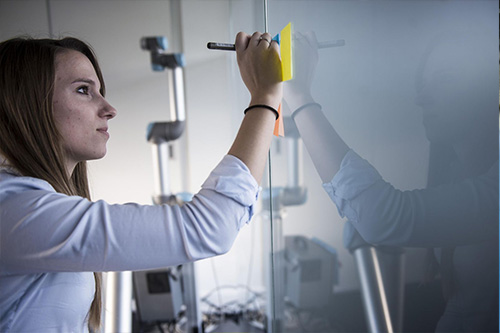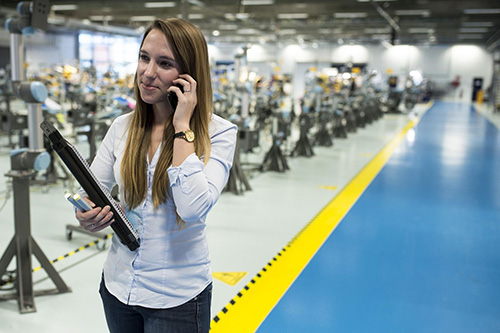Twitter Timeline
FourByThree proposes the development of a new generation of modular industrial robotic solutions that are suitable for efficient task execution in collaboration with humans in a safe way and are easy to use and program by the factory workers.
The project was active for three years, December 2014-2017.
−Last month, members of the FourByThree consortium visited Germany to learn more about the organizations from this country that are taking part in the project, as well as to analyze two of its scenarios: Woll and Premium Aerotec. Together with some material for internal use, an informative video was recorded during the visit. This second video update on the project shows the converging visions of a company (Woll) and a research center (ZeMA).
Last week, members of the FourByThree consortium visited Germany to learn more about the German organizations taking part in the project and to analyze two of its scenarios: Woll and Premium Aerotec. The visit started at Woll’s facilities in Saarbrücken, where complex welding processes were displayed. The tour included a demonstration with a preexisting robot, which gave way to many technical debates regarding FourByThree’s contribution to this kind of scenario.
The group then moved to ZeMA’s nearby facilities. ZeMA is a leading center on the fields of mechatronics and automatisation, and their most relevant projects were covered during the tour. The last day of the visit was devoted to Premium Aerotec’s scenario. In its Augsburg headquarters, the group could learn first-hand about some of the most demanding, repetitive and unergonomic tasks involved in aircrafts’ big parts manufacturing, where human-robot collaboration will play a major role.
In this short video some partners explain the FourByThree project, their contribution and expectations, as well as the next steps. The video was shot during the internal kick-off meeting at IK4-TEKNIKER’s facilities in Eibar, Gipuzkoa, Spain.
After the official kick-off meeting held in Brussels last month, another important milestone will be a visit to the German scenarios. The trip is scheduled for the first week of March and it will cover Woll, ZeMA and Premium Aerotec’s headquarters.
Source: Universal Robots
Collaborative robots (“cobots”) are being adopted at unprecedented rates, due in large part to their user-friendly design. This positive user experience is no fluke. It comes as a result of in-depth research and design and ongoing testing to explore how the robots are actually being used and how they can be continuously improved.
UX designer connects R&D to the real world
Maren Nelson Hadar is a user experience (UX) designer with Universal Robots (UR) whose job is to connect the company’s R&D work with what’s happening in the field so that new products and features meet users’ needs. Hadar visits UR customers to see first-hand how they interact with the robots. “It’s not enough to just hear about what they’re doing,” explains Hadar. “You need to watch people and the robots in action to understand what problems they face on a daily basis.”
Hadar tries to meet with several typical robot users on her site visits, including the production manager, robot operator, and programmer. “The most interesting thing about visiting these companies is how different they are and how differently they use our robots,” says Hadar. “When I go to a smaller company, for instance, the person who programs the robot is often the same person who operates it, so it’s important that programming is easy to access and use. Larger companies might have those people in separate roles. In that case, the programmer might want to lock down the program so that operators just need to be able to start and stop the robot.”

The user’s journey starts by unboxing the robot
Even though UR cobots are easy to use, they’re still sophisticated robots. Some users are novice programmers or operators who aren’t aware of all of the robot’s functionality. UR is always looking at ways to improve the entire user journey, from unboxing to programming, addressing different levels of expertise. While Hadar is onsite, she may be able to point out what users can do to address a particular situation. At other times, the challenges users face provide feedback for where UR can improve, such as with new training material, manual content, and help features. By teaching people how to use the robots in the right way and to their fullest capacity, that can circumvent many challenges that users might experience.
Hadar’s research could ultimately lead to changes in the graphical user interface (GUI) used to program the robots, or where connectors should be located on the robot itself—anything that can improve the user experience. “It’s interesting to see so many different contexts where the robots are being used, but that also makes it very challenging for us,” Hadar explains. “We have to understand all these different interactions, which means that different users will have a very different sense of satisfaction. We need to meet all those needs.”
Patterns help define recommendations for improvements
One of the challenges Hadar faces is how to incorporate such a broad range of user experiences into recommendations for design. She examines her research to identify common thematic elements where needs overlap across a range of customer types and application. She’s looking for patterns in issues that can be solved and how to use those to define features. UX design can also pull users into the testing of new features to get their early feedback.
For example, early UR robots incorporated Modbus TCP for communications, but UR heard from users in different countries that they also wanted Ethernet/IP. Hadar reached out to users in the U.S. to find out exactly what features they needed and that information was used to inform the new communication protocol design. This was released as part of a beta program that allowed users to provide feedback during the development process. “With the final release, we knew it would work and that it would give users just what they needed the first time around,” Hadar states.

Scratching the surface of human-robot interaction
Hadar’s background is in design anthropology with an emphasis on human behavior and interactions with technology. She says robotics is a great field to be in, even for people who aren’t necessarily engineers. “People need robots,” Hadar says, “and not just for manufacturing. We’ve just begun to scratch the surface of how useful robots can be, but we need them to be easy to use. We need to design them in a way that people feel like they can use the robot on a personal level and trust it. That’s the perfect situation for me to be in because I can help bring that to the table.”
Universal Robots is a great place for a UX designer. As Hadar says: “UR is a global company with robots in many countries, and with many different types of users. Part of my job is figuring out how we stay true to our name and create these “universal robots” that everybody in every market will want to use and will find useful. That’s the exciting challenge.”
Source: Ultimaker
By replacing traditional production methods with in-house solutions, 3D printing gives businesses around the world the opportunity to save time and money. ABB Robotics turned to the Ultimaker 2 Extended+ for making prototype fingers for their robot YuMi, bringing new opportunities to the company.
ABB Robotics is a global leader in power and automation technologies. The company develops industrial robots for any kind of application in the automotive, electronics and manufacturing industry. They focus on efficiency and productivity improvement while minimizing environmental impact. Since innovation is a key aspect of their business, prototyping is an important facet. Guillaume Pradels is co-developer of YuMi, a collaborative industrial robot designed to work alongside humans.
“Compared to the traditional aluminium fingers, which were very costly and took about 5 weeks for each iteration, the 3D printed designs cost almost nothing and took about an hour to create”.
YuMi is dedicated to small parts assembly and is designed to grab, pick and place parts and do insertions. For different parts, YuMi needs different shapes of fingers, which requires generating multiple prototypes. The development of the prototype fingers was previously done in-house and for the actual making of the prototypes, ABB traditionally relied on external providers. This was taking a lot of time and money, Guillaume says, so they started to search for alternatives.

When Guillaume brought up the idea of 3D printing at ABB, people were skeptical at first. They were used to applying traditional prototypes made out of metal for their robots, and the idea of replacing these with plastic ones was not welcomed very warmly. Guillaume, who has always been interested in 3D printing, decided to take a design model to a fair to have it 3D printed there. After an hour, the model was printed. When he brought it back to the office, his coworkers were quickly swayed as they saw the result.
Compared to the traditional aluminium fingers, which were very costly and took about 5 weeks for each iteration, the 3D printed designs cost almost nothing and took about an hour to create. When his colleagues could hold the actual result in their hands and see the quality of the print, they were convinced that 3D printing was a solution.

By printing the fingers in-house, ABB speeds up the whole process from several weeks to just a few days as printing only takes a couple of hours. Guillaume remarks:
“As new designs can now be printed from a desktop without having to pass all the stages of ordering and delivery, we save a lot of time and money. We can do a lot more tests that we wouldn’t be able to do without the 3D printing solution”.
Since he first brought up the idea of using 3D printing in his department, other people at ABB have started to look into the possibilities of prototyping and manufacturing in-house.
Curious to see how 3D printing is used in other engineering cases? View 3D printing in engineering.
















